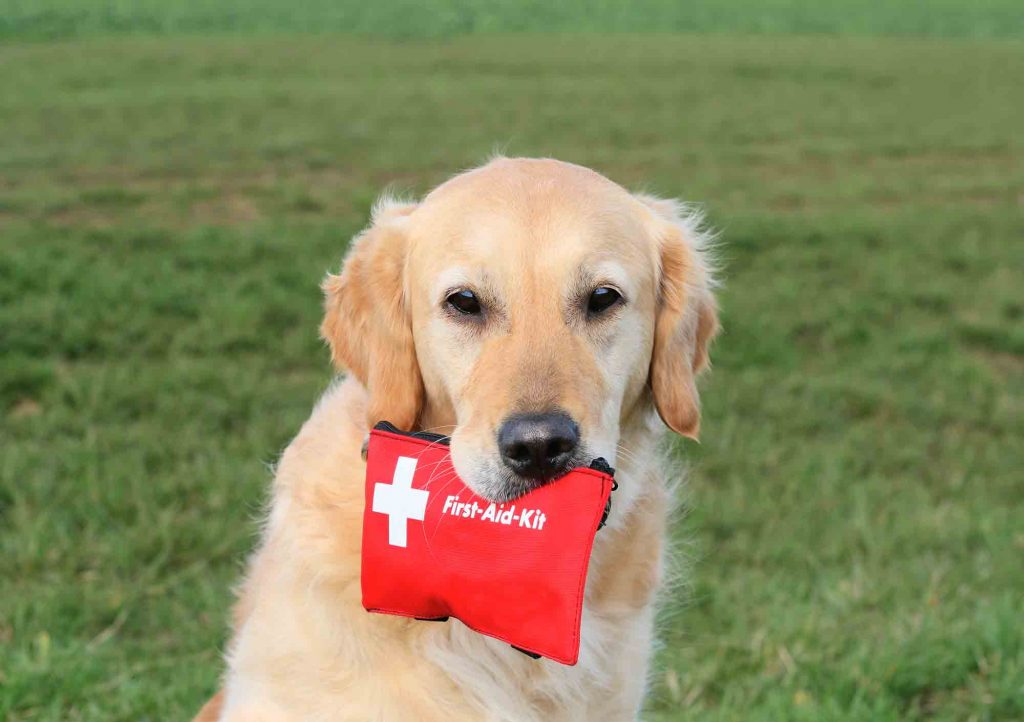 Having a pet first aid kit on hand is a smart idea – after all, we all know a pet (ahem!) who is a little accident prone. A pet first aid kit also comes in handy during a natural disaster or if you’re stranded far from immediate help. With the arrival of camping season and outdoor summer adventures, now is a great time to assemble a pet first aid kit.
Having a pet first aid kit on hand is a smart idea – after all, we all know a pet (ahem!) who is a little accident prone. A pet first aid kit also comes in handy during a natural disaster or if you’re stranded far from immediate help. With the arrival of camping season and outdoor summer adventures, now is a great time to assemble a pet first aid kit.
Basic Pet First Aid Supplies
Here are the basic supplies your pet first aid kit should contain:
- Absorbent gauze pads
- Adhesive tape
- Cotton balls
- Ice pack
- Disposable gloves
- Blunt-nosed scissors
- Tweezers
- Antibiotic ointment
- Alcohol wipes
- Artificial tears eye ointment
- Saline eye wash solution
- Quik stop powder or a small bottle of cornstarch
- Oral syringe
- Towels
- Vet wrap
What Else Should Your Pet First Aid Kit Contain?
There are a few items that should be included in your kit that are specific to pets, so if you’re starting with a human first aid kit, be sure to add these things in, as well:
Include an unopened, unexpired bottle of 3% hydrogen peroxide. This is not for cleaning wounds but to induce vomiting in case your pet ingests something poisonous. This happens more frequently than you might expect. However, don’t induce vomiting without first consulting a veterinarian, as this can sometimes make matters worse.
Keep a bottle of liquid dish soap. This can go a long way toward removing toxins from your pet’s coat and skin. For example, many topical tick medications for dogs are extremely toxic to cats. If your cat accidentally had a tick product applied that was meant for dogs, you can use liquid dish soap to quickly remove most of the toxin before heading in to a veterinary hospital for further help.
Throw in a can of chicken broth or a can of tuna (in water). This can be handy if your pet has eaten a poisonous plant or ingested a household cleaner. Many of these products can cause severe drooling and foaming at the mouth. Using tuna water or chicken broth, you could safely rinse away most of the chemical and its taste. Avoid spraying water from a hose, as this could cause lung aspiration. Of course, a trip to the veterinarian immediately after is crucial.
Pet Disaster Kit
The following items might be handy in the event of a natural disaster or evacuation situation:
- Bag of kitty litter – Keep one with your cat carrier just in case.
- Canned dog/cat food and bottled water – Your pet will need nourishment if you have to evacuate your home. Cans with pop tops are best, since dry food goes rancid after a while, and you won’t have to worry about forgetting a can opener.
- Flashlight – A small flashlight or headlamp is useful in many emergency situations.
Other Tips for Pet First Aid Kits
A couple thoughts to leave you with as you assemble your pet first aid kit:
- Make sure you can readily access the address and phone number of Clairmont Animal Hospital, as well as the contact information for an emergency clinic. You may not always have cell phone coverage, so keep this information on a written card.
- Have the number for the Animal Poison Control hotline in your kit, and have a basic understanding of what is and is not toxic to pets.
- Create a reminder on your calendar to check the supplies in your pet first aid once a year or so. Restock immediately if you use any items.
- Consider signing up for a pet first aid course. You never know when something might happen, and it’s worth the peace of mind.
Do you already have a pet first aid kit? Call us, and let us know what’s in yours! As always, let us know if you have any questions or concerns. We’re here for you and your pet!

